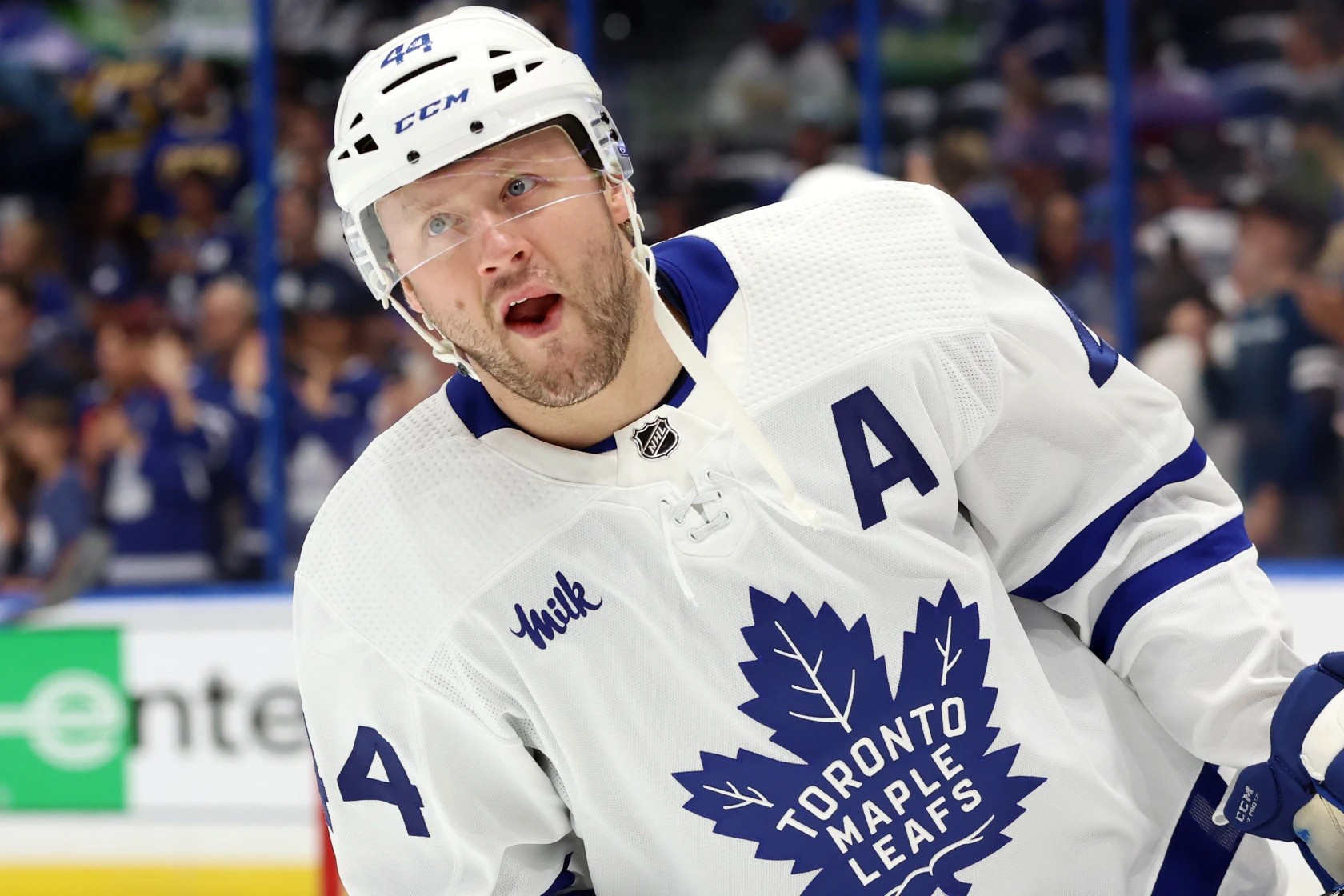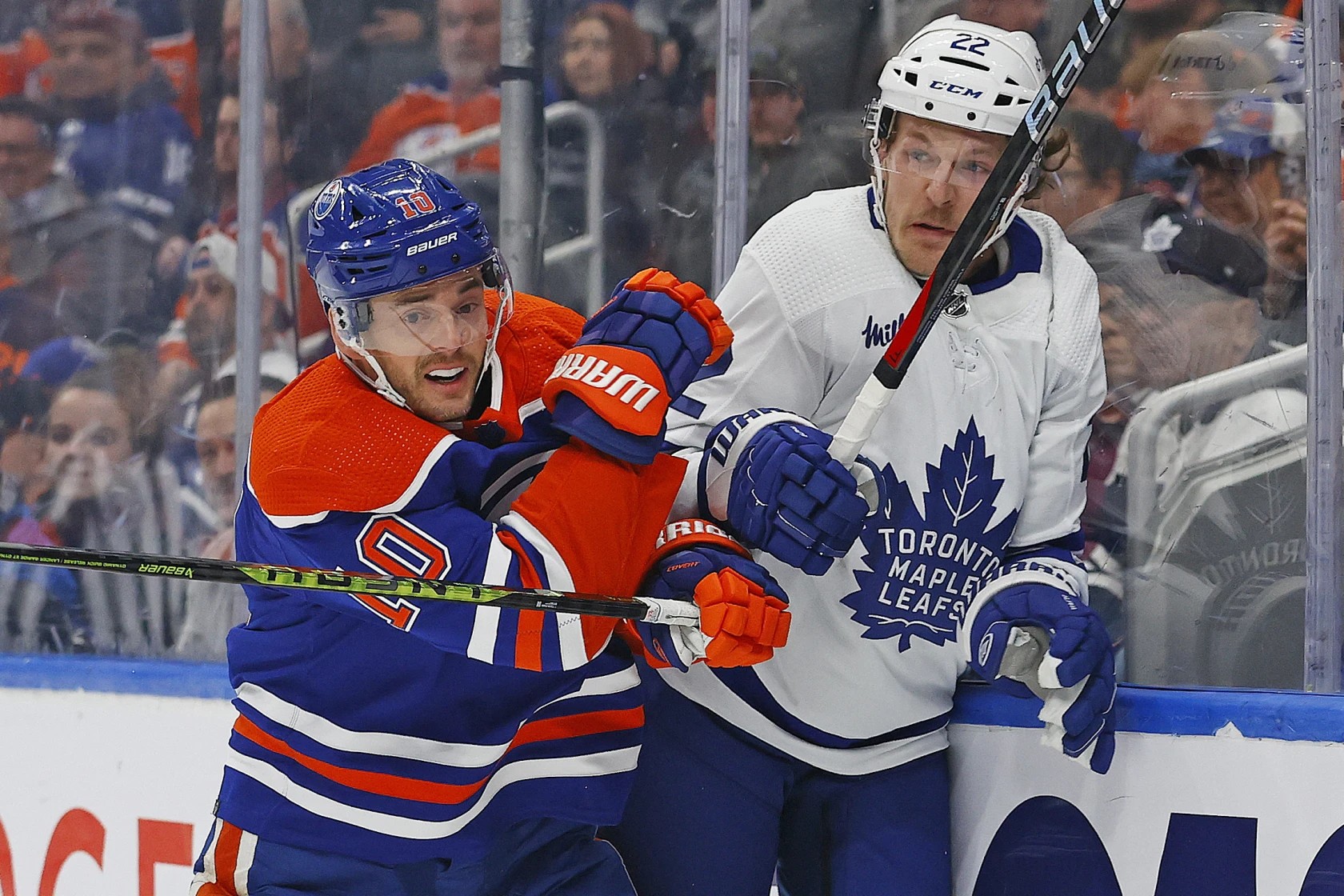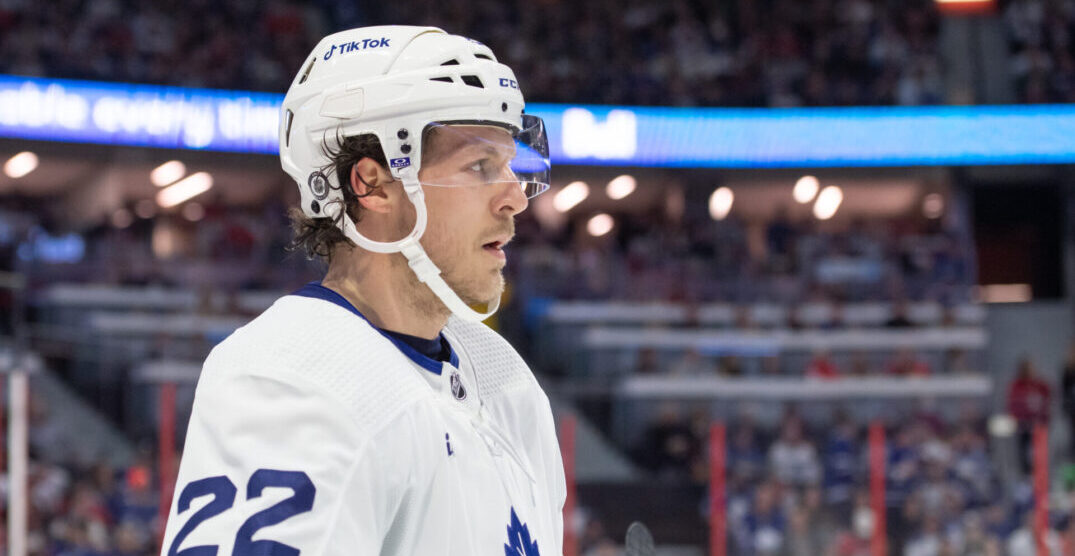As we enter the dog days of the NHL offseason, the Maple Leafs have so far waved goodbye to Justin Holl, Luke Schenn, and Erik Gustafsson on defense while welcoming John Klingberg into the fold.
It still leaves GM Brad Treliving with seven NHL defensemen on his roster (Morgan Rielly, TJ Brodie, Jake McCabe, John Klingberg, Timothy Liljegren, Mark Giordano, and Conor Timmins), but the manner in which the current puzzle pieces fit together — and if the unit is still a key piece short for playoff time — remain very much up in the air as of July 19.
The Maple Leafs defense as it stands

Morgan Rielly
Any analysis of the current Maple Leafs defense should start with their highest-paid player and their undisputed #1 in the most recent playoffs. It’s almost hard to remember the fan frustration with Rielly during the 2022-23 regular season when he followed up what was one of the best years of his career in 2021-22 with a rather subpar campaign — until the playoffs, that is.
As the writers at this site were quick to point out during the regular season, Rielly has consistently been one of Toronto’s best playoff performers during the run of this core, a trend that continued in 2023. Rielly scored four goals and eight assists for 12 points in 11 playoff games, and the goals were 13-4 in favor of the Leafs with Rielly on the ice at five-on-five in the postseason. Rielly scored the OT winner in Game 3 against Tampa and was even robbed of a goal in Game 5 against Florida. He was dynamite in each of the two series the Leafs played in and has amassed 18 points in his last 18 playoff games.
We have enough data to suggest that Rielly is the sort of player who raises his game in the playoffs and earns the full value of his $7.5M contract when the games get tougher. There will be lumps in the regular season, although you’d certainly like to see a return to 2022 form in this upcoming season. Health was a factor for Rielly in 2022-23 — he missed 17 games with injury (his first major injury since 2019-20) — but he’s a fairly projectable player.
The statistics may waver some based on PP usage given that the Leafs have added a possible new PP QB (more on that later), but we can expect Rielly to drive play decently well at 5v5 offensively, struggle defensively (particularly with rush defense), and pile up points on the PP when he plays that role in the regular season. We can expect some consternation to go along with the defensive warts in the regular season, but we can also expect Rielly to ball out in the playoffs.
Rielly is a legit top-four defenseman with a lot of strengths (and one main weakness). You live with the profile, and he earns the contract when it matters. There are no issues there, although he’s not the easiest player to find a partner for. Entering his age 29 (turning 30 in March) season, he’s the easiest Leaf defender to project.
TJ Brodie
The other player with an argument for the number-one defenseman role on the team through much of the past regular season is TJ Brodie. The defensive specialist has been one of the NHL’s best defensive defensemen for years now and he was every bit of that in the 2022-23 regular season, with the team’s defensive results varying wildly based on whether Brodie was in the lineup or out of it. The Leafs were a demonstrably better defensive team with Brodie playing in the regular season. It’s no surprise given how Brodie is deployed: playing top competition either on his own pair or balancing out Rielly and eating immense minutes on the PK. He’s been such a rock for the team since signing in Toronto, which is why his showing in the playoffs was rather startling.
It was not clear if Brodie was injured during the postseason or what was going on, but the defenseman looked slow and generally out of sorts for large stretches. We should note that the numbers were not terrible overall. The Leafs were outscored 8-6 with Brodie on the ice at 5v5 in the playoffs, but the expected goals, scoring chances, and high-danger chance numbers were all around or above 50%. By no means was Brodie getting caved in — which is not nothing given the list of offensive firepower he was facing every shift against Tampa and Florida — but #78 looked wobblier than normal at times.
I don’t think it’s time to hit the panic button, but scaling back Brodie’s role some, especially in the regular season, wouldn’t be a bad idea. He turned 33 in June and dealt with two separate injuries during the 2022-23 regular season. Ensuring he’s fresh and at his best for the playoffs should be an area of emphasis going into the upcoming season, but the basics of his role likely won’t change. He’s going to focus on the defensive side of things.
Jake McCabe
Brodie’s playoff partner was Jake McCabe, one of the two high-profile trade deadline acquisitions that Kyle Dubas made in his final season on the job. McCabe has two years remaining on his contract at just $2M thanks to the retention from Chicago secured in the terms of the trade.
McCabe was tremendous for the Maple Leafs in the regular season after the deal, tilting the ice in Toronto’s favour and owning his minutes, which led Sheldon Keefe to pair him with TJ Brodie for the postseason as the head coach recreated his “shutdown pair” from the preceding season with Jake Muzzin next to Brodie. That’s where things took a turn for the worse as McCabe had some real ups and downs just as Brodie did, although McCabe’s metrics were quite a bit worse than Brodie’s.
Context is important as this was McCabe’s first taste of playoff hockey despite logging 504 NHL regular season games up to that point (playing for the 2010s Buffalo Sabres for eight seasons will do that). There was likely an adjustment period going on with McCabe, and I don’t doubt that he will be a bit better prepared to handle NHL playoff hockey in the spring of 2024 than he was in the spring of 2023.
However, there is still a question mark, based on his performance this past spring, as to what McCabe’s ideal role ought to be on a playoff team. He’s certainly not prime Jake Muzzin, but that’s okay (he’s not paid like he is). McCabe has plenty of positive attributes: some willingness to join the rush from time to time, the physicality in throwing big hits, and general tenacity. But I’m not sure he’s the best match to play with TJ Brodie on a “shutdown pair.”
For one, I don’t like the idea of such a pair, to begin with, a pair that exists only to play defense. Every team has a pair it deploys against top competition, sure, but I think you should build that pair around the idea of tilting the ice, not merely nerfing the other team’s top stars. In other words, I don’t like the line of thinking circulated by some Leafs writers built around the question, “Who should defend against Nikita Kucherov?” I’d rather ask the question, “What are the best pairs we can put together to win minutes against tough opposition?”
The pursuit of finding two defensive players who could play against a Kucherov and Point line is perhaps what got us to the McCabe-Brodie tandem, a group that seemingly lacked the footspeed and puck-moving ability to work well together. Brodie has very little offensive ability left in his toolkit and McCabe has never been that sort of player ever (hence why he has five career PP points). For all that people praised Jake Muzzin’s defensive abilities — and they were legit — we often forget that he was a stellar offensive defenseman, too. He played the power play and recorded 40+ points three times in his career. Even the reduced Muzzin of the 2022 playoffs still had more puck-moving juice than either McCabe or Brodie. To me, that element is what was missing from the pair.
I believe there is a pathway for McCabe to win minutes against good competition in the postseason, but I don’t think it’s with TJ Brodie. Rather, pairing both players with more gifted puck-moving partners may be the best way to maximize their abilities and deliver positive results for Toronto.
John Klingberg
The next highest-paid Leafs defenseman is offseason signing John Klingberg, who is a reclamation project, to say the least. Klingberg, once an incredible NHL defenseman, has fallen on hard times.
Up through 2020 or so, Klingberg was just about as good as it got in terms of an offensive defenseman in the NHL. He was logging 24 minutes per night, driving tremendous offense at 5v5 as well as on the PP, where he was one of the league’s slipperiest puck handlers — a genius at tightrope-walking the blue line and finding angles to pass and shoot. He scored 67 points in 2017-18 and finished sixth for the Norris Trophy twice. When the Dallas Stars made their surprising run to the Stanley Cup Final in 2020 in the bubble, Klingberg scored 4-17-21 in 26 games, playing 23:20 per night for Dallas.
He put together an okay season in 2020-21 before reportedly turning down a massive contract extension in order to bet on himself — a bet that went completely bust. Klingberg struggled mightily and ran up a -28 with 5v5 impacts that were treading water in the regular season while getting outscored at even strength in actual goals. Klingberg was caved in in the playoffs against Calgary before Dallas made the decision to go in another direction.
After no great offers materialized in the offseason, Klingberg fired his agent and signed a prove-it deal in Anaheim. Unfortunately, he proved nothing with a disastrous defensive season for the Ducks, arguably the worst defensive defenseman on the NHL’s worst defensive team in 25 years. He was traded to Minnesota for very little at the deadline and didn’t fare terribly well in the regular season.
If there’s one shining light here, it’s a solid 2023 playoff. Paired with rookie Brock Faber fresh out of the University of Minnesota (Matthew Knies’ teammate), Klingberg found his footing and the two posted stellar numbers at 5v5 (2-0 in goals, 56.08% xGF%). He scored four points in four playoff games even as the Wild were defeated by the Stars, Klingberg’s old team.
As we look toward 2023-24, the Leafs are paying Klingberg $4.15M, which is a bit of a hefty price for a reclamation project but we have to be honest about said price. Points are what get defensemen paid, and Klingberg still scores points — 33 in 67 games last year thanks to all that PP time in Anaheim. He also was making $7M last season on a deal signed in the summer of 2022, so there was just no way Klingberg was taking a haircut down to the range of $2M or something. If you wanted him, this was the price, and the Leafs did want him.
Brad Treliving seemed to identify puck-moving ability as something the Maple Leafs were lacking, and I agree with him on that count. Klingberg is just a risky bet given how poor the defensive results have been recently and how his career has trended. There is a credible argument for signing Shayne Gostisbehere (who ended up in Detroit) instead, but Klingberg has high upside. Unlike Gostisbehere, who has largely been an ~18-minute-per-night defender, there was a time when Klingberg was a bona fide number one, including during a trip to the Cup Finals. That counts for something.
The question for the Leafs and Klingberg is how they plan to use him and what partner can stabilize Klingberg. The Swede is a RHD, so if they wanted to play him with TJ Brodie, they would need Brodie on his more natural left side, even though he has almost exclusively played the right in Toronto (he did play the left next to Conor Timmins some last year). Jake McCabe would be an option that makes some sense potentially, while Morgan Rielly is obviously off-limits for stylistic reasons.
Some have pointed to Klingberg’s salary as a reason why the Leafs must play him in the top four, but I hate using salary to determine role, especially when salary for a defenseman is so tied to points, which are largely a derivative of power-play time. To me, the best role for Klingberg may be on a third pair of sorts, playing 16 minutes in the playoffs (as he did in Minnesota), receiving offensive zone starts, and playing on the PP, be it PP1 or PP2.
If the Leafs can find a partner who can work with Klingberg — and the coaching staff helps correct some of his defensive problems (turnovers have been a huge issue) — there’s a legitimate asset here. Klingberg is still very talented offensively and his evasive abilities at the blue line are something the team really lacked in the postseason. Vegas’ Shea Theodore showcased to the hockey world how useful it is in the playoffs to have defensemen who can break down the first layer of coverage high in the offensive zone, creating numerical mismatches down low and getting shots through traffic on net.
That is Klingberg’s signature skill as an NHLer, and the Leafs’ only defender with it in their repertoire in 2022-23 was Morgan Rielly. However, they have to find a way to get Klingberg to the 10th percentile defensively (rather than the 0th) to make it worth it.
Timothy Liljegren
With Justin Holl departing in free agency, Timothy Liljegren will be looked to as a younger piece who can take the next step.
Midway through the past regular season, we were all singing the praises of Lily, who was excelling on a pair with Rasmus Sandin when the Leafs’ D was ravaged by injuries and continued to play well when matched with other players, including Mark Giordano. Liljegren looked to be making a jump into a top-four role, but then things turned complicated.
Toronto’s decision to acquire three defenders at the trade deadline and begin running 11/7 bumped Liljegren out of the everyday lineup and shuffled around the pairs. When Liljegren played, his performance declined precipitously. He seemed to lose his confidence, and when the playoffs started, Liljegren was on the outside of the starting lineup. Liljegren ended up playing in five playoff games, joining the lineup after Holl was removed due to atrocious play. He was largely fine — no points but limited disaster moments as well.
As we look toward 2023-24, Liljegren is a player to watch. While he’s been in the organization for six years, it’s important to remember that Liljegren has only played 141 NHL games and is still only 24. If we use the 300-game watermark for judging an NHL defenseman, Liljegren still has at least two years until he reaches that point. He’s shown pretty strong flashes over the past two seasons, but he has gotten bumped in the big moments for Holl. Now with Holl out of the picture, it would seem to be Liljegren’s time to shine.
It would not be crazy if Liljegren emerged as a legitimate top-four defenseman, nor would it be crazy if he showed himself to merely be a third-pairing D after all. There are some aspects to like about Liljegren: he’s faced reasonable competition and won his minutes, has logged notable time on the PK, boasts decent size at 6’1″, and has some legitimate offensive abilities for a player who rarely plays on the PP. Over the past two seasons, Liljegren’s 1.04 points/60 at 5v5 ranks 47th among NHL D who played at least 100 games, ahead of John Klingberg and only a tad behind Alex Pietrangelo.
I’d expect Liljegren to be in the lineup regularly to show the Leafs what he has to offer with a spot secured and a clearer defensive depth chart.
Mark Giordano
Maybe the biggest question mark among defensemen currently on the Leafs’ roster is Mark Giordano. At the end of the 2023 regular season, Giordano was still a rock-solid defenseman who shouldered a considerable load defensively. By the time the playoffs were up, fans were justified in wondering if Giordano planned to continue his NHL career.
The 39-year-old defenseman, the NHL’s oldest active skater, aged decades in the span of a few weeks and put together a brutal showing in the playoffs. Giordano looked too slow to keep up with the play, crumbled under pressure, and made frankly baffling errors. Justin Holl garnered (justified) anger from Leaf fans for his play, but Giordano was nearly as bad for stretches. After playing nearly 19 minutes per game in the regular season — second-pairing minutes — Giordano was relegated to a small third-pair role in the postseason, averaging under 15 minutes per game. He played under 10 minutes in each of the final three games against Florida.
At this point, the main question with Giordano is what he has left in the tank. Assuming he plans to suit up for another season, the offseason ought to give him a chance to rest up and get his legs back underneath him, but I don’t think you can go into 2023-24 planning for Giordano to play any substantial role in the playoffs. The team can do a better job of managing him before the postseason — giving him more days off and lessening the load in the games he plays — but we’ve likely already seen the best of Giordano in Toronto. He can probably provide steady play in the regular season, but he should be counted on for very little once the spring rolls around based on what we saw this past spring.
Conor Timmins
The final name on defense that is signed onto the NHL roster right now, Timmins was a savvy pick-up by Kyle Dubas in December given that he was acquired for basically nothing and gave the Leafs 25 solid games, mostly during the period when the blue line was swamped with injuries.
Timmins meshed well with TJ Brodie and provided some offense to the lineup, but ultimately, he was not sturdy enough defensively or against top competition to carve out a regular role. He fell out of the rotation altogether after the trade deadline, but he is on the books for two more seasons at just $1.1M against the cap.
While Timmins could certainly leave if the Leafs are making a change on defense, I wouldn’t mind keeping him around given that he is a right shot, has decent size at 6’2″, and provides the puck-moving ability that the team didn’t have in spades in their playoff lineup last spring. Who knows if the 24-year-old could play himself into a real role in the starting lineup, but he’s an interesting piece who is cheap enough that there’s no harm in keeping him around as the seventh defenseman. Injuries will happen, and a playoff-bound team needs solid depth. Timmins offers that right now.
The remaining needs on defense, and thoughts on Brad Treliving’s approach

As the Maple Leaf defense stands right now, Rielly, McCabe, and Giordano are LHD who typically play the left, while Klingberg, Liljegren, and Timmins are RHD who typically play the right. TJ Brodie is a lefty who can play either side but has more often played the right in Toronto. From a handedness standpoint, it seems fine. From a quality standpoint, it does feel like the team is perhaps missing one piece.
Conor Timmins has yet to demonstrate he’s an NHL defenseman worthy of regular minutes in a playoff series, while Mark Giordano was last seen playing his way out of such status. That’s the crux of the situation.
Rielly, McCabe, and Brodie are legitimate top-four defensemen of varying stripes, in my book. Liljegren and Klingberg could possibly fill top-four roles this upcoming season, but it’s not clear if they will be up to it. In a perfect world, you’d like to add one more true top-four defender to round out this group, taking less pressure off Klingberg and Liljegren, not to mention Giordano. The question is, who? The free agent market is completely barren at this point and the trade market isn’t exactly appetizing, either.
The most logical trade target name might be Calgary’s Nikita Zadorov. The Leafs have expressed some interest in the Calgary defenseman, according to the offseason rumor mill, which makes sense given that Brad Treliving is now the GM. Treliving tends to like bigger-bodied defensemen, and the Leafs don’t have much in the way of those right now.
Zadorov would bring this element in an emphatic fashion. The towering 6’6″ Russian has reinvented his career in Calgary; last season, he played nearly 19 minutes per game, posting excellent results and scoring 14 goals in the process. Zadorov’s heaviest minutes came on the PK, which could be of use to the Leafs, who will not have Justin Holl around to soak up those minutes (not to mention a possible plan to cut back the workload for Brodie/Giordano). He was second on the Flames in hits at 174 as well. A left shot, Zadorov could give the Leafs a left side of Rielly/McCabe/Zadorov, providing the foundation to build three strong pairs.
It makes a lot of sense on paper, but it isn’t easy to pull off. For one, it’s not clear if the Flames are selling Zadorov. Secondly, his cap hit at $3.75M is not easy to fit under the cap and would require some pieces going out to make it work (plus possible retention). Zadorov is entering the final year of his deal, so if things don’t go as planned for Calgary in the regular season, he is someone who could be available at the deadline, if a deal can’t be made now. It’s something to keep an eye on, but the combination of price and logistics doesn’t make it a walk in the park.
While Zadorov would add a missing element and strengthen the group, he isn’t quite the hoss that some Leafs fans would like to add to the top end of the blue line. A borderline top-pair defenseman would obviously be a boon, but I’m not sure how that happens without trading William Nylander for said player. Noah Hanifin of Calgary and Brett Pesce of Carolina have been the most rumoured as both are heading into the final year of their contract, but the price will be steep and an extension would have to be part of the equation. Either player would make the Leafs’ defense a ton better and allow them to lessen the load on Brodie, in particular, with perhaps Pesce providing the closest thing to a real “Muzzin replacement.”
We should also address the fact that there is some question with TJ Brodie himself and Brad Treliving. The two know each other from their days in Calgary, a time when Treliving didn’t appear to be the biggest fan of Brodie. He attempted to trade Brodie to Toronto in the original Nazem Kadri trade (which fell apart) and then let Brodie walk to the Leafs the following offseason, signing Chris Tanev instead. That seems to be the source of rumors about the Leafs moving or buying out Brodie. While Treliving may not love Brodie, it makes very little sense to me given how important Brodie is to the blue line’s makeup. Does getting rid of Brodie just to add Pesce make them dramatically better? I don’t really think so. Ideally, you’d like to have Brodie and add Pesce.
Ultimately, the Leafs’ defensive group right now is not a bad one. They have three quality defensemen who can play in the top four, a young and promising defenseman who has a shot to solidify himself in that role this season, and a reclamation project who was once among the best of the best. When we toss in the intriguing Timmins and the aging Giordano, it’s a fine mix — for the regular season, at least.
Given the quality of players the team has at forward and in net, I have no doubt that if the Leafs ran this defensive group out there for the regular season, they’d be a playoff team again and likely would have among the best records in the league again. It’s not a five-alarm fire or a major weakness, by any means.
But I also can’t help but feel a bit nervous at the prospect of entering the playoffs with this group. TJ Brodie is aging and experienced injuries and a wobbly playoffs last year. Mark Giordano may not have much of anything left. Conor Timmins and Timothy Liljegren are both largely unproven in the postseason. If John Klingberg doesn’t hit it big with the Leafs, it feels like they will be going into the 2024 trade deadline in need of a defenseman, should Treliving choose to enter the 2023-24 regular season with this blue line.
The moves of the offseason so far — signing Klingberg as the lone new defender and scooping up Max Domi and Tyler Bertuzzi on offense — definitely improve the Leafs’ offensive potential. I would expect Toronto to be a better offensive team this year. At the same time, it feels like they are a little bit weak on defense for a playoff series after subtracting defensive acumen from the forward lineup with the departure of Noel Acciari and Ryan O’Reilly, plus the likely age-related declines of some of their defensemen.
Treliving doesn’t have to address the defense now and the dead trade market suggests it may not be terribly likely that he does. If he doesn’t, expect it to be a focus at the 2024 trade deadline as the Leafs load up to make a run for the Stanley Cup. That may well be the best idea given that it would let the Leafs take stock of Liljegren and Timmins’ development, Brodie and Giordano’s health, and Klingberg’s performance with his new team. In other words: See how this uncertain group of players is performing, diagnose any issues, and try to find a solution in the trade market.
Unless, of course, they’re trading William Nylander in the next couple of months — in which case, all bets are off, and I’d expect a top-four defenseman to be a part of the return. No matter what happens, I’d be quite surprised if these seven defenders are the same seven defenders on the Maple Leafs roster when the 2024 postseason gets underway.

































